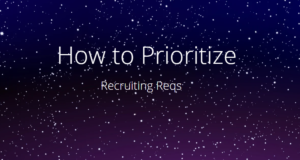
Do you feel overwhelmed by the number of job req openings in your organization, and do you sense an urgent need to fill them all immediately? If so, take a moment to step back and take a deep breath. Given the challenges of the past several years, having the opportunity to expand your headcount in 2023 and beyond is a positive development I wanted to write a post to guide other recruiters on effective problem-solving, setting realistic expectations and goals with hiring managers, and prioritizing recruiting requisitions for a successful year. The post will demonstrate how these skills can be used to successfully prioritize recruiting req needs and achieve hiring goals.
It’s understandable to feel pressure to make the right hires, especially for smaller organizations that are carefully managing their growth. Fortunately, there are strategies you can use to streamline the process and reduce stress.
Break down your process
One effective approach is to break down the hiring process into three basic categories: prioritizing, communicating, and preparing. By focusing on each of these elements, you can make the process more manageable and successful.
📋 Here are some ways to prioritize:
Take inventory of your process:
Create a list of all open jobs and note the recruiting stage and the estimated work required to fill each position. Don’t neglect “easy wins.” Prioritize jobs where the candidate pipeline is moving faster.
Know your biggest obstacles:
Identify the biggest challenges related to closing your jobs, such as the quality of the candidate pipeline or scarcity of candidates. The sooner you identify impediments, the faster you can adapt your process.
Think back to the business:
Consider the immediate and long-term needs of the business when prioritizing a given hire. Ask yourself if the job has a high impact on products, services, or projects, if it’s a core job critical to the mission, or if it’s a key management role.
Set a Job Target:
Determine if the job can serve as an internal promotion, if the responsibilities can be distributed, or if the exact job needs to be filled.
Evaluate the urgency of each position:
Once you have identified your hiring needs, evaluate the urgency of each position. Determine which positions need to be filled immediately, and which can wait.
Review your candidate pipeline:
Review your candidate pipeline to determine which positions have the most promising candidates. Prioritize those positions where you have a good pool of candidates to choose from.
Consider the impact on the company:
Prioritize positions that have a significant impact on the success of the company. This may include key leadership roles, critical technical positions, or roles that support key business functions.
Assess the difficulty of filling the position:
Consider the difficulty of filling the position. Prioritize positions that are more challenging to fill and require more time and resources to source and screen candidates.
Communication will be key:
It’s crucial throughout the recruitment process. Let managers know that progress is being made, even if they aren’t interviewing anyone. Encourage managers to help move the process along by sourcing candidates or considering internal candidates. If finding the right candidates becomes too difficult, consider re-evaluating the recruitment and hiring strategy or Job Target.
Preparing proactively:
Determine which areas of the organization have the highest potential for future growth and which departments are at risk of turnover. Keep a silver medalist list of interviewees who might be a good match for future jobs.
By prioritizing, communicating, and preparing, you can hire the right employees faster and more efficiently. Start by setting the right Job Targets, so you can find your next successful employee.
Building a Relationship with your Hiring Managers is vital for success long term
Building a solid relationship with a hiring manager is crucial to understanding which roles need prioritization. A good relationship with the hiring manager allows a recruiter to better understand the hiring manager’s priorities and the needs of the company.
Here are a few reasons why building a solid relationship is important:
Better understanding of job requirements: A strong relationship with the hiring manager allows the recruiter to understand the specific requirements for each job opening. This understanding allows the recruiter to prioritize the roles based on the business impact and the urgency of the hiring manager’s needs.
Improved communication: Good communication is key to a successful recruitment process. Building a strong relationship with the hiring manager allows the recruiter to communicate more effectively and efficiently. The recruiter can provide timely updates and receive feedback, which can help in prioritizing roles.
Clear expectations: When the recruiter has a strong relationship with the hiring manager, there is a clear understanding of the expectations for each role. This includes the required skills and experience, the salary range, and the timeline for filling the position. With clear expectations, the recruiter can prioritize roles based on the needs of the company.
Increased trust: A strong relationship between the recruiter and the hiring manager builds trust. This trust is essential for a successful recruitment process. The hiring manager needs to trust that the recruiter understands the company’s needs and will find the right candidate for the job. With trust, the hiring manager is more likely to prioritize roles based on the recruiter’s recommendations.
Creating Realistic Expectations:
Holding a hiring manager accountable for prioritizing job requisitions is important for a successful recruitment process. Here are a few ways to do so:
Establish clear criteria: To hold a hiring manager accountable, it’s important to establish clear criteria for prioritizing job requisitions. This includes understanding the business impact of each role, the required skills and experience, and the urgency of filling the position. By having these criteria in place, the hiring manager can be held accountable for prioritizing roles based on these factors.
Regular check-ins: Regular check-ins with the hiring manager can help ensure that job requisitions are being prioritized correctly. These check-ins can be in the form of status updates on each job requisition or regular meetings to review the hiring process. During these check-ins, the recruiter can ask the hiring manager about the status of each requisition and why certain positions are being prioritized over others.
Metrics and reporting: Establishing metrics and reporting can help hold a hiring manager accountable for prioritizing job requisitions. These metrics can include time-to-fill, quality of hire, and cost-per-hire. By tracking these metrics and reporting them to the hiring manager, the recruiter can hold them accountable for prioritizing job requisitions based on the company’s hiring goals.
Review candidate pipeline: Reviewing the candidate pipeline with the hiring manager can also help ensure that job requisitions are being prioritized correctly. The recruiter can provide regular updates on the quality and quantity of candidates in the pipeline for each role. This can help the hiring manager understand the progress being made on each requisition and make adjustments to prioritize roles as needed.
🚫 Saying – “No” well:
As a recruiter, it can be difficult to say “no” to a hiring manager, but it’s important to be honest and transparent to maintain a good working relationship. Here are some steps you can take to say “no” to a hiring manager:
Listen carefully: First, listen carefully to the hiring manager’s request and ask any necessary questions to fully understand the situation. Make sure you understand the hiring manager’s priorities and the reasons behind their request.
Explain your reasons: If you need to say “no” to the request, explain your reasons clearly and honestly. Be specific about why the request is not feasible or why you cannot prioritize it at this time. Provide alternative solutions or suggestions where possible.
Offer alternatives: If you cannot meet the hiring manager’s request, offer alternative solutions that could meet their needs. This could include adjusting the timeline, revisiting the job requirements, or exploring other sourcing options.
Be respectful and professional: When saying “no” to a hiring manager, it’s important to be respectful and professional. Be mindful of your tone and language and focus on maintaining a positive working relationship.
Follow up: After you say “no” to a hiring manager, make sure to follow up and check in on the status of the request. This shows that you still care about the hiring manager’s needs and are willing to help find a solution.
In summary, it’s important to be honest and transparent when saying “no” to a hiring manager. Listen carefully, explain your reasons, offer alternatives, be respectful and professional, and follow up to ensure a positive working relationship.
Final Thoughts…
Becoming skilled at prioritizing your requisitions and managing your workload can result in filling more jobs more efficiently, leading to greater success as a recruiter.
Recommended Reading:
Cody Horton Interview: Diversity Sourcing Expert
Maisha Cannon the Talent Genie Interview
Create a Talent Sourcing Metric Funnel Calculator
- Unlocking the Power of Perplexity AI: Why Recruiters Should Utilize This Revolutionary Tool - February 11, 2024
- Exploring AI Interviewing Assessment Tools: A Comprehensive Review - November 30, 2023
- PartyRock a Sandbox for Talent Sourcing - November 29, 2023
